Ambassador Update Series: Finishing My Service in Samoa (Part 2)
Mr. Gen-ichi Terasawa
(Continued from part 1)
The Importance of the Pacific Island Nations
Advanced and developing nations in the international community have faced various problems under the COVID-19 pandemic, and an inward-looking tendency within the public has appeared. In regards to aid for the Pacific Islands as well, the international community shows a lack of interest in the matter, questioning why they need aid in the first place. On the other hand, not only for Japan, but these Pacific Island nations are actually important for the international community.
The Pacific Island nations are spread widely across the Pacific Ocean divided into the three diverse regions of Micronesia, Melanesia, and Polynesia (Samoa belongs to the last). When looking at a map, excluding Papua New Guinea, almost all the islands appear as just dots. However, the territorial waters that belong to these island countries and their Exclusive Economic Zone (EEZ) comprise of more than half of the Pacific Ocean; in terms of shipping routes as well as commercial fishing in these waters, Japan and the international community are dependent on these territories. It is needless to say that it is of upmost importance to maintain and strengthen the international order in these waters. Furthermore, these island nations are all pro-Japan, actively supporting the Japanese stance on the international stage, such as at the UN, so that Japan can better articulate and act on its position on the international arena. For example, when Japan declared its bid to become a permanent member of the United Nations Security Council or at the time of the election of senior positions of important international organizations, the Pacific Island nations advocated for Japan. Samoa and other Pacific Island countries consistently support Japan’s international position and candidacy.
Additionally, as global issues such as climate change and marine pollution in recent years have become more severe, the role of the Pacific Islands has rapidly been expanding on the international stage, where international concerted efforts are required. The international role that the Pacific Island countries play is expanding; for example, the May 2019 Asia Development Bank’s (ADB) general meeting and the 2017 COP23 hosted by Fiji and the 2018 Asia-Pacific Economic Cooperation (APEC) hosted by Papua New Guinea.
In particular, there are not only benefits for those on the receiving end of aid given to support the frail health system, but also benefits for the givers of such aid. This is because, as seen with the current COVID-19 pandemic, that infectious diseases spread throughout the world in the blink of the eye through the highly developed modern transportation network and its numerous human movers. If blank zones of disease control measures appear in developing countries, they have the probability of becoming the center of the next outbreak to envelope the world. Assistance for the health sector of developing regions not only benefits donor countries such as Japan, but also the international community’s security in regards of the public health. I believe that the development and education of much needed health workers in the Pacific Island region is of upmost importance in order to drastically strengthen their currently frail health system. It is a race against the clock to make vast changes to strengthen the medical and nursing educational institutions in the region, while simultaneously increasing the number of doctors and nurses, as well as educate the community on public health matters.
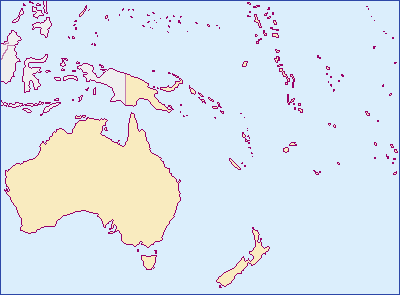
(Map of Oceania, courtesy of MoF)
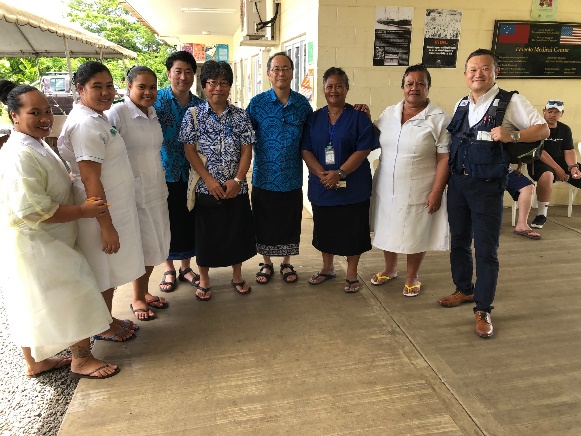
(Island nation’s medical problem: lack of medical staf)
The Pacific Islands, important partners for Japan, face a number of problems, which are big constraints to economic and social development, such as limited and dispersed land; far from the international market; and vulnerable against natural disasters and climate change. In order to strengthen the partnership between Japan and these countries, Japan created the Pacific Island Leaders Meeting (PALM), a place to hold summit-level talks to discuss solutions to the above-mentioned problems and to aim for stability and prosperity in the region. PALM has been held in Japan every three years since 1997. Currently, a total of 19 countries and regions, including Japan and PIF (Pacific Island Forum) members (these include 14 island countries, Australia, New Zealand, New Caledonia, and French Polynesia) participate in PALM meetings.
As I mentioned briefly before, PALM9 was held online in July 2021 (originally scheduled to be held in Shima City, Mie Prefecture, but due to COVID-19 restrictions it was held remotely). The PALM Leaders reiterated their commitment to further strengthening this important partnership, a partnership underpinned by mutual trust and respect as well as shared values such as freedom, democracy and respect for human rights and the environment. The PALM Leaders acknowledged that the PALM partnership is becoming even more important in meeting emerging challenges in the region including the COVID-19 pandemic. Specifically, the PALM Leaders expressed their commitment to working together on five priority areas of cooperation for the next three years; 1. COVID-19 response and recovery; 2. Sustainable oceans based on the Rule of Law; 3. Climate change and disaster prevention; 4. Strengthening foundation for sustainable and resilient economic development; 5. People-to-people exchanges and human resource development. Of these areas, the PIF Leaders welcomed Japan’s announcement of Japan’s Pacific Bond (KIZUNA) Policy, which would further strengthen the cooperation between Japan and the PIF members through “All Japan” efforts based on Japan’s Free and Open Indo-Pacific vision. The end of the meeting resulted in the adoption of “the Leaders Declaration” and “the Joint Action Plan for Strengthening Pacific Bonds and for Mutual Prosperity” expressing plans to work together in order to strengthen the bond between Japan and the Pacific Island region and for mutual prosperity.
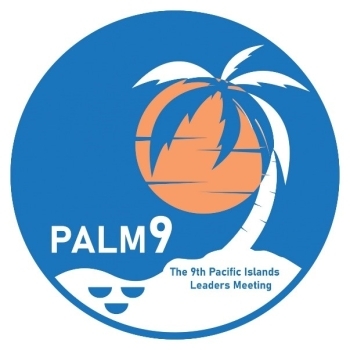
(PALM9 logo (courtesy of MoFA website))
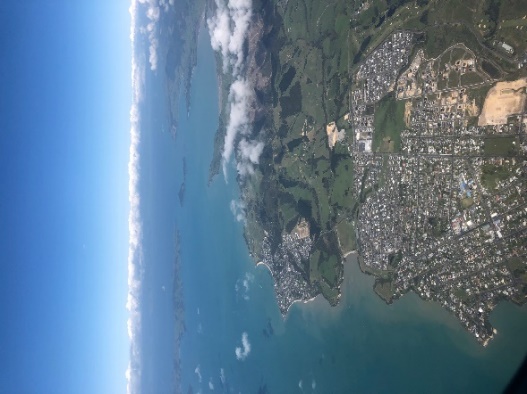
(Aerial view of Samoa’s capital, Apia. After leaving the city land quickly turns to rural area dotted with small villages)
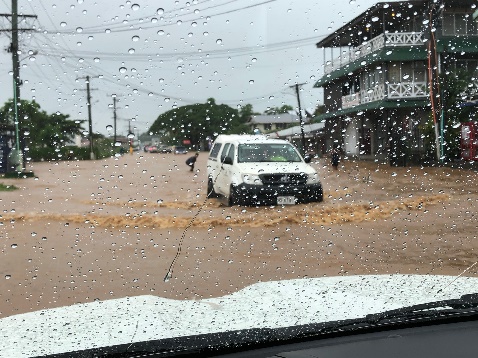
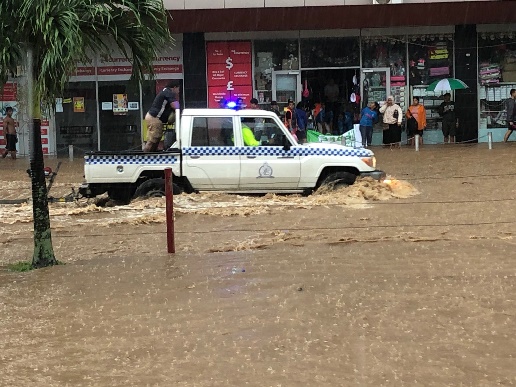
(Disaster prevention is a main topic in PALM meetings. Floods occur every time heavy rains batter the islands)
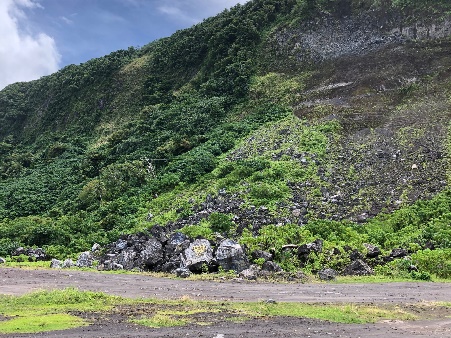
(Disaster prevention: landslide due to earthquake.)
All of the previously-mentioned five priority areas discussed at PALM9 are areas that Japanese aid programs have shown strength in. In this section I will give examples from recent years to illustrate a part of Japan’s strength in aid-giving.
(1) Vaisigano Bridge Reconstruction (2017 fiscal year. Grant aid limit: 1.8 billion JPY. Completed 2020.)
As flood disasters are frequent in Samoa, the bridge Vaisigano Bridge which connects the main port of the capital Apia and the city center started to deteriorate and became a visible danger; driftwood caught under the bridge during heavy rains due to the outdated structure with bridge piers caused floods to occur. In order to improve this condition, Japan put its aid behind a project to rebuild the bridge using highway network maintenance and disaster prevention measures to instead use an arch form in order to reduce the number of bridge piers. This project was placed under the priority categories of disaster prevention, climate change, and sustainable development aid at the 2015 PALM7 meeting in Iwaki, Fukushima prefecture.
What should be noted as a reason why this project was highly praised by Samoa is not the high quality of the bridge itself, but the benefits entailed with the transfer of technology from Japanese construction companies to local companies. In other words, although Japanese construction firms also played the role of contractors, they focused on giving on-site commands and subcontracting to local construction companies. This not only allowed the latest technology to be transferred to local contractors, but also contributed to the employment of the local workforce. Compared to the Chinese format of aid, Samoa placed higher appraisal on this type of Japanese aid. China also financially backed several construction projects, but all were done using Chinese construction firms and Chinese construction workers without using any local companies or workforce, which did not lead to the transfer of technology nor did it invigorate the local workforce. The problem with the Chinese method is that after a project is completed, Chinese firms and workers pick up everything and leave, and when maintenance is required it is difficult for local contractors to fix the problem as the building plans remain unknown.
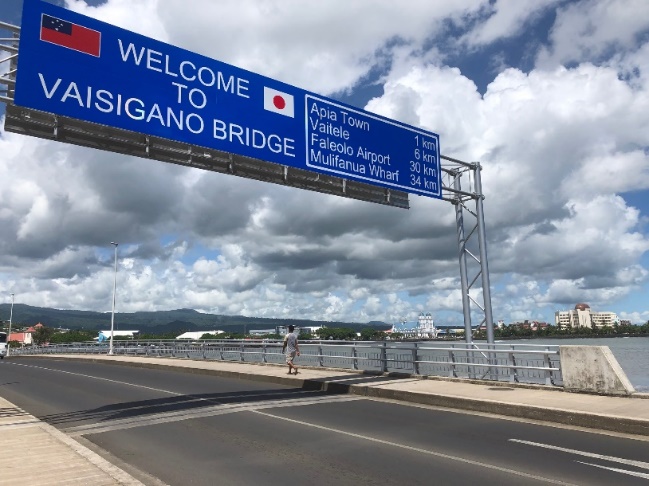
(Vaisigano Bridge rebuilding project. The project not only strengthened disaster prevention infrastructure, but also contributed to the training and employment of local firms.)
Samoa is home to SPREP (Secretariat of the Pacific Regional Environmental Programme), which is dedicated to responding to the urgent challenges that climate change is posing for the regions’ island countries. Japan, in conjunction with strengthening the SPREP Climate Change operations, in order to provide assistance to the development of human resources in the region, provided assistance to build the Pacific Climate Change Centre (PCCC) and to design the curriculum of the Centre’s human resource development program. The construction of the PCCC was completed in 2019, and currently JICA experts have been dispatched to design the human resource development program. This project was labeled under the category of the disaster prevention, climate change, and environment aid at the 2015 PALM7 meeting.
What should be noted about this project is that Japan’s assistance not only included construction of the Centre, but also included human resource development. A country’s development advances with capital and human resources. Together with capital, the capacity development of human resources is indispensable for the leaders who bear the responsibility of developing the country. In this respect Japanese aid towards the PCCC’s human resource development was high received.
What drew even more attention was the aid collaboration with New Zealand. Excluding the experts used for the human resource development component of the project, New Zealand provided the labor costs needed at the PCCC. Each project requires various costs, and since aid-providing countries have their strengths and weaknesses in each given area, and it is difficult for only one development partner to provide for all costs due to budget restrictions. Japan’s financial cooperation’s weak point is granting aid for bureaucratic and labor costs; however, New Zealand has a financial aid scheme which was able to handle the labor costs. Furthermore, New Zealand is a “like-minded ” country that shares the same principle values such as freedom and democracy. There are voices coming from inside Japan proclaiming that Japan must increase its aid for developing countries in order to compete with China, who is investing large sums of money for grant projects in these countries. Additionally, there is movement from grant-receiving developing countries to prefer Japanese support fine-tuned to local need. On the other hand, Japan does not have the financial ability to give aid to every developing country. I personally believe that in the future if China respects the sovereignty of developing countries and abides by international rules, it is possible for Japan and China to collaborate on grant projects; however at the moment the situation is difficult. Thus, if Japan collaborates with other “like-minded” nations to fund grant projects, it will be possible to share capital and labor on large-scale projects.
Apart from PCCC project, there are other examples of aid collaboration projects while I was in office. Grants were given to a local organization that carries out a public glass and plastic recycling program; although the allotted aid for this project was not a large amount, we were able to construct a warehouse facility for the recycling facility. The recycling systems used in the facility were made by splitting costs among JICA, USA, Britain and UNDP to complete an overall excellent environmental protection project. This became a positive symbol of aid collaboration between “like-minded" countries.
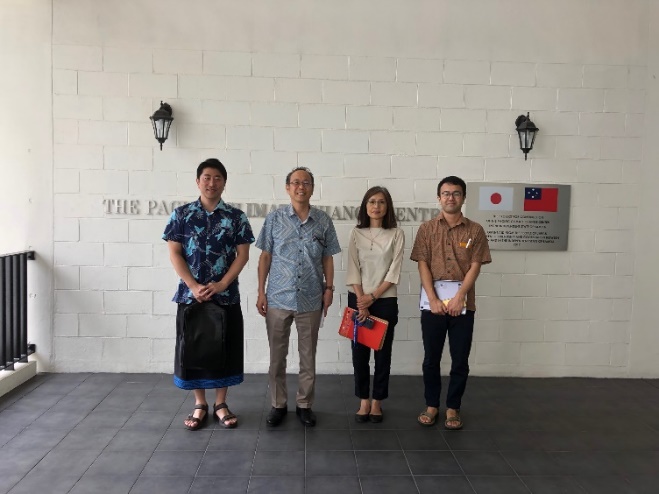
(Pacific Climate Change Centre (PCCC). Photo taken with experts partaking in the training program.)
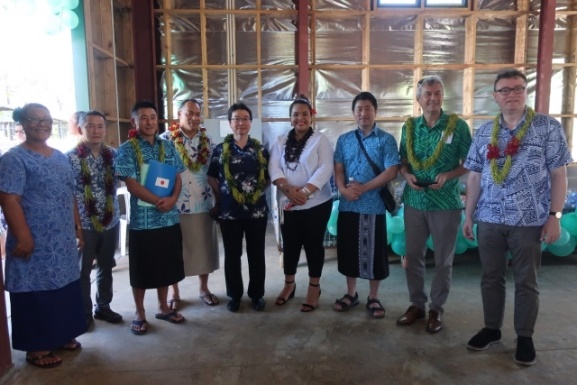
(Opening ceremony of the plastic and glass recycling facility. This project is a good example of aid collaboration between Japan-Britain-US-UNDP.)
“GGP ” is a scheme based on the ideals of human security, that provides grant assistance to support relatively small projects that are located in developing countries with the goal of developing the economy and which have direct benefits to local residents. Eligible organizations for “GGP” are non-profit regional public organizations, educational institutions, medical institutions, NGOs, etc. located in developing countries. My office used this scheme in Samoa to support a variety of projects in the local community.
The improvement of elementary, middle, and high school buildings, which results in improving a poor educational environment, is developing human resources who will participate in building up the nation in the future. Grant aid towards educational facilities is important from the perspective of “visible aid”. In front of the many schools that Japan has given aid stands a sign with the Japanese flag and the Samoan flag; as the youth of Samoa grow, they will see these signs every day as they go to school.
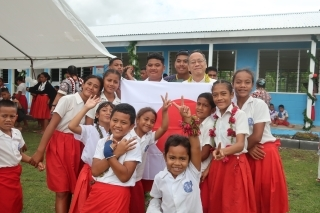
(Improving school buildings. Commemorative photo with children at the Handover Ceremony.)
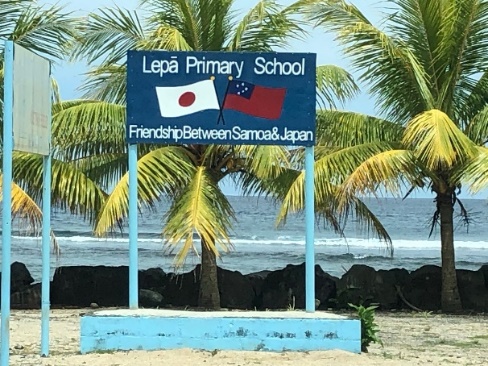
(Signs all over Samoa with the Japanese and Samoan flags. Japan has given aid mainly to school construction projects.)
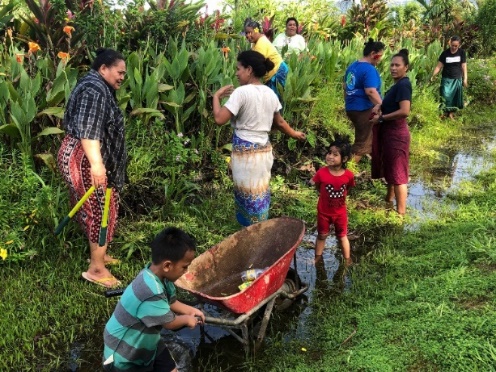
(Women volunteering in the local community pictured cleaning and maintaining village roads.)
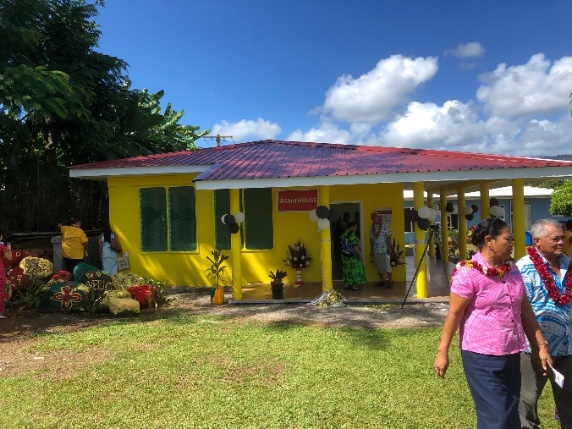
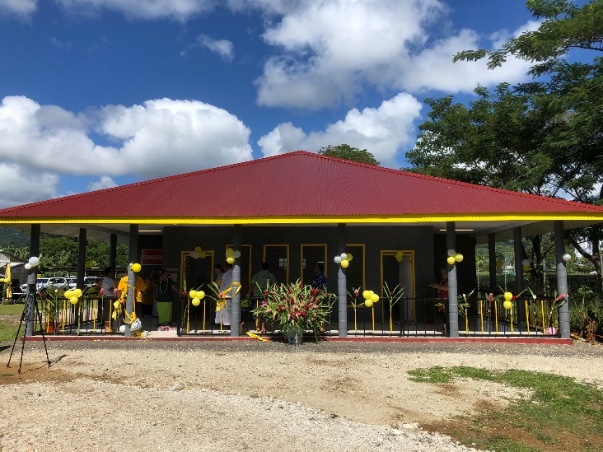
(Grant aid given to build two shelters to house victims of domestic violence and child abuse.)
I can’t talk about Japan’s high-quality and comprehensive aid programs without introducing JICA’s technology-transferring expert and volunteer dispatch program. These types of technology transfer projects have been well-received by Samoan society. In addition to the previously mentioned PCCC human resource development program, JICA has sent experts to the project of the J-PRISM (Japanese Technical Cooperation Project for Promotion of Regional Initiative on Solid Waste Management in Pacific Island Countries) in collaboration with the SPREP (Secretariat of the Pacific RegionalEnvironmental Programme). This project produced highly skilled human resources in the waste management area, not only in Samoa but in the entire Pacific Island region. They are now able to train others to follow in their footsteps in other island and developing countries, headed into the south-south cooperation stage.
Additionally, the overwhelming placement of JICA volunteers in Samoa has helped to develop human resources on a community level. For example, the aforementioned school improvement projects do not guarantee a high level of education; a high-quality education needs high-quality teachers and materials. JICA placed volunteers on-site to aid in the transferring of teaching technology. Speaking from personal experience, I have noticed that people in developing nations have a tendency to focus on the construction of buildings that stand out from the rest, but do not take an interest in developing human resources. This is why the placement of volunteers for transferring the technique of creating high-quality education and educational materials is of upmost importance. JICA volunteers are starting to head back to Samoa after packing up and returning to Japan due to the COVID-19 pandemic, but due to border regulations redeployment is at a standstill. We are hoping that Japanese aid and volunteers will be able to return as quickly as possible.
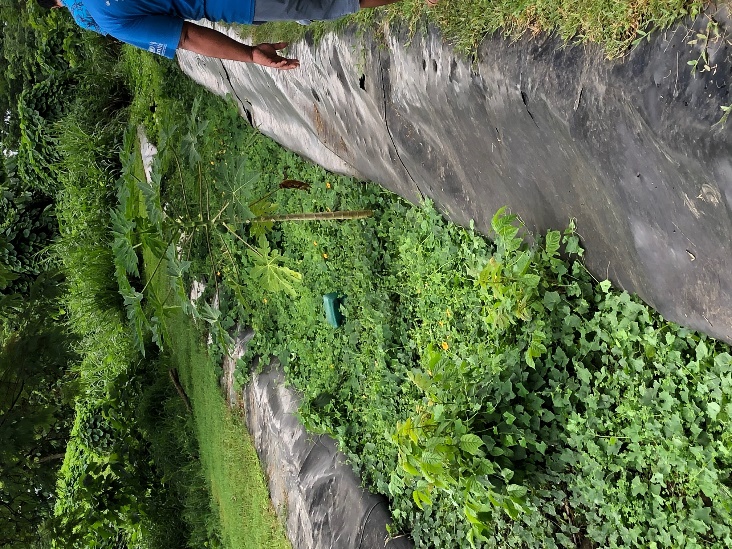
(The “Fukuoka method” (semi-aerobic landfill concept) used in Samoa is making an impact in waste management)
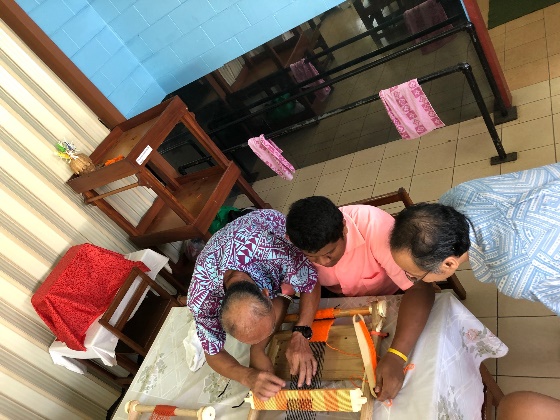
(JICA volunteers introducing a training program for youth with disabilities at a vocational school to support self-reliant)
In conclusion, I would like to introduce projects that Japanese private organization APIC (Association for the Promotion of International Cooperation) has undertaken to provide aid to Samoa. As a part of its operations, APIC has carried out training invitation programs, taking the invited participants’ country background into consideration when planning the details and types of programs it plans on offering. When planning for the 2020 Samoa Leader Invitation Program, Japan was the destination country for the participants, and APIC incorporated organizations promoting the domestic island regions as part of their program. It is not realistic to introduce businesses which have dropped large-scale capital in order to acquire the latest technology, to human resources in island countries that have capital and technological restrictions. Rather, APIC put together a program that introduced small, local businesses in the town of Amacho, Shimane Prefecture, which have been successful in making use of the charm of the area and its strengths. I was looking forward to this program, but unfortunately it was postponed due to the COVID-19 pandemic. Just as with the JICA volunteer program, I cannot stop praying for the end of the pandemic and the restart of the above mentioned programs.
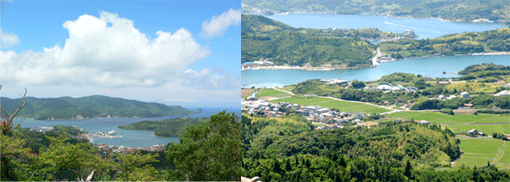
(Amacho, Shimane Prefecture (Provided by Amacho official website))
WHAT'S NEW
- 2025.12.25 UPDATE
PROJECTS
"Barbados A Walk Through History Part 17"
- 2025.12.2 UPDATE
EVENTS
"Pacific & Caribbean Student Invitation Program 2025"
- 2025.10.30 UPDATE
EVENTS
"Support for the 2025 Japanese Speech Contest in Jamaica"
- 2025.10.30 UPDATE
EVENTS
"Invitation Program for the Director of Bilateral Relations of the Ministry of Foreign Affairs and Trade of Jamaica"
- 2025.10.16 UPDATE
EVENTS
"421st Lecture Meeting Regarding Global Issues"
- 2025.9.18 UPDATE
EVENTS
"420th Lecture Meeting Regarding Global Issues"
- 2025.8.28 UPDATE
PROJECTS
"Barbados A Walk Through History Part 16"
- 2025.7.17 UPDATE
EVENTS
"419th Lecture Meeting Regarding Global Issues"
- 2025.6.19 UPDATE
EVENTS
"418th Lecture Meeting Regarding Global Issues"
- 2025.5.15 UPDATE
EVENTS
"417th Lecture Meeting Regarding Global Issues"




